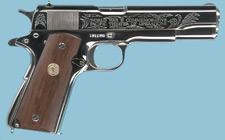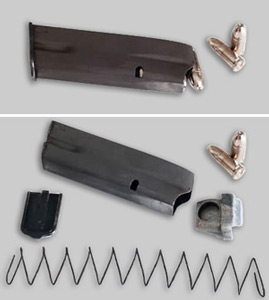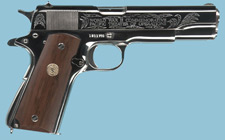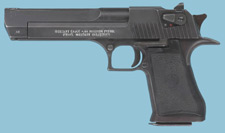Home | Glossary | Resources | Help | Contact Us | Course Map
Archival Notice
This is an archive page that is no longer being updated. It may contain outdated information and links may no longer function as originally intended.
Autoloading - Semiautomatic Pistols
Semiautomatic pistols are typically magazine-fed repeating firearms that require a separate pull of the trigger to fire each shot. The energy of discharge performs some of the firing cycle functions such as extraction, ejection, cocking, and loading.
These pistols are magazine fed; a box type magazine is loaded with cartridges and placed into the magazine well, which is usually located in the pistol grip. Magazines are generally single or double stacked. The double-stacked type can hold a larger number of cartridges.
With the magazine in place, the slide is pulled to the rear and released.
This action
- cocks the firearm,
- strips a cartridge from the magazine,
- inserts the cartridge into the chamber,
- locks the breech.
Most semiautomatic pistols have one of three major actions:
- Blowback
- Recoil
- Gas
There are other variations of these basic semiautomatic systems, such as retarded or delayed blowback. This module covers the three major actions.
Blowback Action
The blowback system is comprised of an unlocked breech that relies on the mass (weight) of the breechblock and the strength of the return spring to prevent the breech from opening and the cartridge case from being exposed during its period of peak pressure.
Low-pressure cartridges are generally used in blowback action pistols; however, there are several pistols that use high-pressure cartridges. These pistol systems tend to be heavier because the slide must be large enough to hold the firearm in battery until peak pressure is reduced. An internal striker or an external hammer is typically present. A visual check should determine the type of firing mechanism.
Recoil Action
The recoil action is a locked breech system that relies on the recoil of the firearm at discharge to unlock the breech. The time required for the breech to unlock allows for the reduction of peak pressure within the chamber. High-pressure cartridges are generally used in recoil-action pistols. An internal striker or an external hammer is typically present. A visual check should determine the type of firing mechanism.
Gas-Operated Action
The gas-operated system is a locked breech system in which gas is bled from the barrel to move a piston rearward, unlocking the breech and cycling the firearm. The gas port is located near the muzzle and peak pressure is reduced before the gas is bled off. High-pressure cartridges are generally used in gas-operated action pistols. An external hammer is typically present.
Additional Online Courses
- What Every First Responding Officer Should Know About DNA Evidence
- Collecting DNA Evidence at Property Crime Scenes
- DNA – A Prosecutor’s Practice Notebook
- Crime Scene and DNA Basics
- Laboratory Safety Programs
- DNA Amplification
- Population Genetics and Statistics
- Non-STR DNA Markers: SNPs, Y-STRs, LCN and mtDNA
- Firearms Examiner Training
- Forensic DNA Education for Law Enforcement Decisionmakers
- What Every Investigator and Evidence Technician Should Know About DNA Evidence
- Principles of Forensic DNA for Officers of the Court
- Law 101: Legal Guide for the Forensic Expert
- Laboratory Orientation and Testing of Body Fluids and Tissues
- DNA Extraction and Quantitation
- STR Data Analysis and Interpretation
- Communication Skills, Report Writing, and Courtroom Testimony
- Español for Law Enforcement
- Amplified DNA Product Separation for Forensic Analysts







